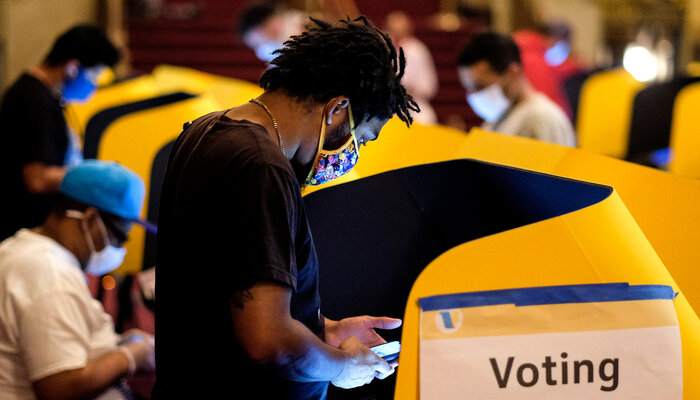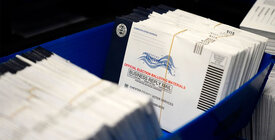
Preclearance Under the Voting Rights Act
For decades, the law blocked racially discriminatory election rules and voting districts — and it could do so again, if Congress acts.

Part of
The Voting Rights Act of 1965 was a hugely successful law in the fight to ensure that every American can vote, especially in communities of color. But a 2013 Supreme Court ruling hollowed out the landmark civil rights measure by effectively ending a provision of the law known as “preclearance.”
What is preclearance?
Prior to 2013, Section 5 of the Voting Rights Act required states and localities with an extensive history of racially discriminatory voting practices to submit any changes in their election laws and policies or electoral district maps to the federal government for advance review before putting them into effect, a process known as preclearance.
Courts and the U.S. Justice Department have interpreted Section 5 to apply to a wide category of election-law related laws, ranging from statewide redistricting plans and voter-ID laws to changes as small as a local government’s relocation of a polling place from one church or school to another nearby.
The purpose of preclearance was to ensure that any changes in these “covered jurisdictions” did not discriminate against voters of color, either in their purpose or in effect.
Section 5 is unique. Other voting rights laws, including other sections of the Voting Rights Act, require that the government or adversely affected minority voters bring a lawsuit to challenge a law and prove in court that the law is discriminatory. This process is often both time-consuming and costly. Worse, until litigation concludes, the discriminatory law often remains in effect, harming the ability of minority communities to have effective access to the ballot.
By contrast, under Section 5, covered jurisdictions had the burden of proving to the satisfaction of federal reviewers that a new law was not discriminatory. This quickly had a transformative effect, both in policymaking and in rates of participation by minority voters.
What were the effects of preclearance?
Before the Voting Rights Act, the invalidation of a discriminatory practice by a federal court was often met with resistance from state and local governments, who either used procedural maneuvering and endless appeals to avoid compliance or simply adopted an equally discriminatory alternative that required aggrieved voters to go back to square one.
With the duty under Section 5 to seek federal review of their proposed voting policies, covered jurisdictions quickly moderated many of the worst abuses. Eventually, many even began adopting voting laws and redistricting plans with an eye to satisfying the concerns of minority voters and ensuring that the new laws would secure federal preclearance.
The success of preclearance led Congress to repeatedly include it in renewals of the Voting Rights Act. When the law was first passed, the preclearance provisions were set to sunset in 1970. However, their effectiveness prompted Congress to extend its operation four times, most recently in 2006, when renewal passed the House 390–33 and the Senate 98–0 before being signed into law by President George W. Bush.
Ultimately, it would be the Supreme Court, not Congress, that would put a pause to preclearance. In Shelby County v. Holder in 2013, the Court controversially invalidated the coverage formula used to determine what states and local governments were required to comply with the preclearance requirements. As a result, no states or localities are currently required to get federal approval for changes to election rules.
What states and localities were covered by preclearance?
At the time of the Shelby County decision, 16 states were subject, in whole or in part, to Section 5 preclearance requirements.
While the majority of these states were in the South, covered jurisdictions also included Alaska, Arizona, and certain counties and townships in California, Michigan, New Hampshire, New York, and North Dakota.
In nine states (Alabama, Alaska, Arizona, Georgia, Louisiana, Mississippi, South Carolina, Texas, and Virginia), preclearance requirements applied both to the state government and all or nearly all local governments within the state.
How did preclearance work?
When Section 5 was in place, a covered jurisdiction making changes to election rules could seek preclearance of changes through one of two routes: approval from the Justice Department or a federal court.
By far the most common method was the former. Under a process known as administrative review, the jurisdiction could submit the proposed change along with any requested information to the Justice Department. The department then had 60 days, extendable under certain conditions, to notify the jurisdiction of whether it had objections.
If the Justice Department did not object, preclearance was deemed granted and could not be challenged further in court. If, however, the DOJ denied preclearance, the jurisdiction could seek review of the denial before a federal district court in Washington, with further appeals possible to the Supreme Court.
The second route for obtaining preclearance was to seek approval of an election law or voting map change by filing a lawsuit in federal district court in Washington. But this route was infrequently used given the time and cost of litigation compared to the more streamlined administrative preclearance process.
Why did the Supreme Court end preclearance?
In Shelby County v. Holder, the Supreme Court ruled that the formula used by the Voting Rights Act to determine what states and localities were subject to Section 5 was unconstitutional because it was based on electoral conditions in the 1960s and 1970s rather than contemporary circumstances and thus imposed unequal burdens on some states without sufficient justifying evidence.
Importantly, though, the high court did not strike down Section 5 altogether. Instead, it left open the possibility that “Congress may draft another formula based on current conditions” using “current data reflecting current needs.”
What is the status of efforts to adopt a new coverage formula?
Congress has repeatedly tried and failed to adopt a new Section 5 coverage formula, but there are signs that it is inching ever closer to success. In January 2022 the House passed a package of democracy reforms that included the John R. Lewis Voting Rights Advancement Act, which would have updated the Section 5 coverage formula. Though the package commanded the support of a majority of senators, it narrowly failed due to the inability of the body to reform its archaic filibuster rules.
Since then, evidence pointing to the devastating impact of the end of preclearance has only continued to mount. Indeed, a Brennan Center study found that since 2013, the turnout gap between white voters and Black voters “grew almost twice as quickly in formerly covered jurisdictions as in other parts of the country with similar demographic and socioeconomic profiles.”
While the current Congress seems unlikely to prioritize passage of voting rights legislation, it is not difficult to envision a reform-oriented majority in the near future that will — especially if the public demands reforms to renew and strengthen American democracy for the 21st century.
More from the Explainers collection
-
NATO’s Article 5 Collective Defense Obligations, Explained
Here’s how a conflict in Europe would implicate U.S. defense obligations. -
Facts and Myths About the Uniformed and Overseas Citizens Absentee Voting Act
Military personnel, aid workers, and other Americans living abroad have a right to vote, and there is a secure system that lets them do it. -
How Elections Are Certified in Battleground States
State laws require officials to certify results, and safeguards are in place should someone fail to fulfill that obligation.



